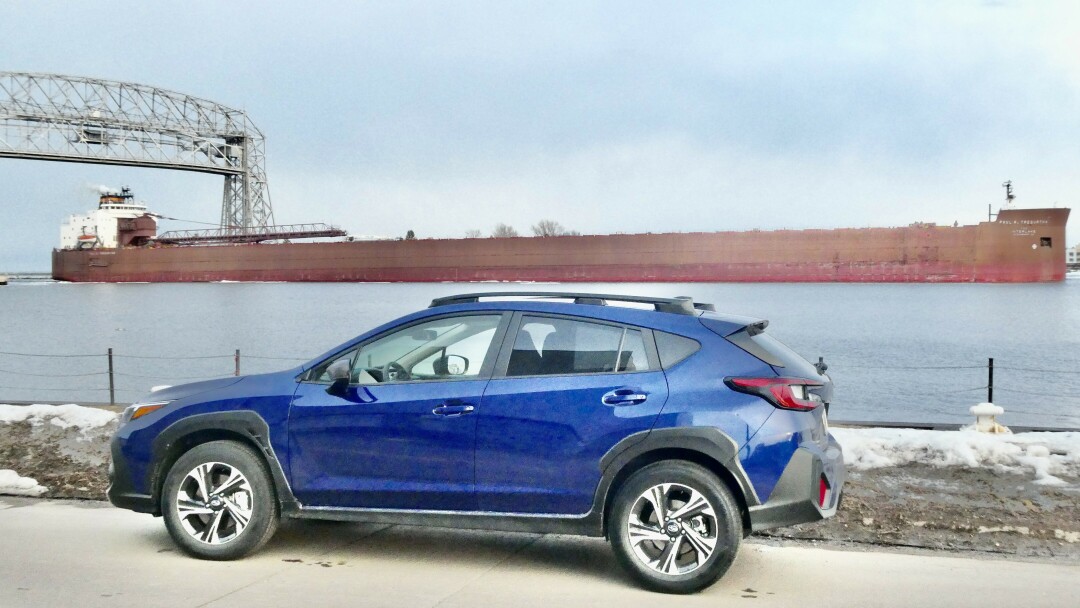Crosstrek for 2024: New slant on family hauler

There were a lot of years when I didn’t have a “favorite” Subaru, except for the explosively-fast turbocharged WRX STi model of the Impreza, which was successful in high-speed rally competition and bared its fangs for the public, too.
As my “hot-rodding” instincts become more controllable, my new favorite Subaru is the Crosstrek — a tight and tidy little station wagon or small SUV, or however you categorize it. I just had the chance to road-test a 2024 Crosstrek, and it is better yet, ratcheting up my feeling that it’s a bargain to purchase, and to operate, and should be a prime candidate for anyone seeking a compcact and surprisingly roomy little SUV with all-wheel drive to challenge the nastiest parts of winter and pothole season.
It doesn’t hurt my sensitivities that the test Crosstrek came in Sapphire Blue Pearl, a rich, darker-than-royal blue that is eye-catching, especially to a blue person like me. It fairly glows like a jewel in different light, and it stood out especially when we came up with a sunny day and blue skies on the North Shore of Lake Superior.
The tester was not quick, but quick enough, accelerated adequately, and, as I drove it up and down Duluth’s steep hillsides, it delivered an honest 30 miles per gallon, a figure I found adequate and a cut above the days when I was disappointed in most every Subaru I drove.
On top of that, with the standard one-speed CVT transmission manually shiftable to any of eight shift points with steering wheel paddles, you could enjoy the driving without even having a continuously variable transmission to complain about.
The engine is an invigorated 2.0-liter direct-injected 4-cylinder, with 152 horsepower and only 145 foot-pounds of torque. That’s not much, but without turbocharging, it is adequate. Especially after you enter the freeway three or four times thinking it’s pretty docile, and then you accept that and learn to enjoy it, using the paddles to run the revs up.
It has a 1,500-pound towing capacity, and its fuel economy estimates are 27 city and 34 highway for a combined figure of 20 miles per gallon.
With a wheelbase of 105.1 inches and an overall length of 176.4 inches, Subaru was able to keep the Crosstrek’s weight down to a svelte 3,296 pounds. Impressive, considering the 10 percent stiffer chassis and the all-new revised exterior design. Adding an all-weather package and blind-spot detection with one-change assist and rear cross-traffic alert, plus a power moonroof, still only boosted the sticker price to $29,685.
We enjoyed cruising along the North Shore and finding our spots along the Duluth Harbor to watch some of the first lake freighters cruise into port under the Aerial Bridge.
My ongoing relationship with Subaru has taken various twists and turns, with my sarcasm generally settling on a couple of things. For one, the little Japanese company decided to copy the highly successful German style of Volkswagen, and Porsche, and build engines that were low and flat, horizontally opposed pistons instead of the norm of in line and upright 4-cylinders.
For another, Subarus were Subarus long before anyone started using the term Sport Utility Vehicles (SUV), and yet when the SUV moniker caught on, Subaru jumped in line to pretend it had invented the genre, whereas I always thought the company should have just kept its PR mouth shut and capitalized on how the industry had come to them with a bonanza.
My complaint in more recent years has been that Subaru discovered that if it beefed up its flat-4 and flat-6 engines and applied turbocharging, it could wrench great quantities of power out of modest-sized displacement, and if you stuffed it into a compact or subcompact Impreza, you could have yourself a world-beater — literally — with the WRX Sticker.
That all made automotive sense, because everybody marveled at the potency of the WRX STi, and it was a blast to drive, Since then, however, I felt as though Subaru became enamored with its power and whenever they build a new vehicle, they walked a tightrope between power and economy — and almost always took the power side.
Whenever I tested any Subaru, it always disappointed me with its inability to challenge or beat other compact or subcompact vehicles with quick engines and lofty miles per gallon. Finally, a couple of years ago, I discovered that I was partially to blame for Subaru’s poor fuel economy, because when I’d test one, if I drove it at 70-75 legal freeway speed, it would deliver gas mileage well below its own EPA estimates, and I’d blame the engineering.
But then one week I had the occasion to do some statewide trips across Minnesota without using the interstate system, and to my surprise, I learned that if I kept it at 55-60 miles per hour, the fuel economy might hit 30. A revelation.
The Crosstrek is now joined by several larger vehicles in the Subaru family, but the more models that proliferate, the more I feel comfortable enjoying the Crosstrek. this one had active torque-vectoring for cornering on slippery surfaces, auto start-stop that kills the little 4-cylinder engine when you’re at a stoplight, incline start assist, adaptive LED headlights that anticipate when you’re going to make a turn, x-Mode hill-decent control, dark grey 17-nch alloy wheels, keyless access and starting LED foglight, StarLink connectivity, and Subaru’s specialty, the Symmetrical all-wheel drive.
